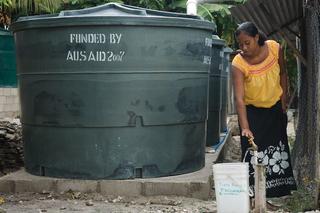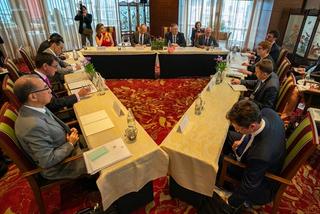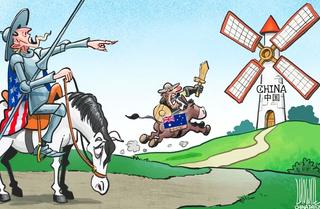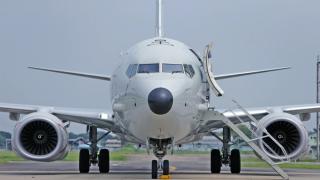Summary of recommendations
Advance health, development and infrastructure goals
- Australia and the United States should intensify their existing partnership on strengthening health systems resilience in the Pacific.
- Australia and the United States should work with Japan to recommit to and significantly expand a trilateral development agenda for the Indo-Pacific.
- Australia and the United States should work to ensure the Indo-Pacific has robust digital infrastructure and support technology standards which are equitable, industry-set and multilateral.
Counter state-based disinformation and cyber threats
- Australia and the United States should strengthen their organisational capacity to counter state-backed disinformation and preserve the integrity of the alliance’s shared information landscape.
- Australia and the United States should align their healthcare cybersecurity efforts, sharing best practices and connecting cybersecurity public-private partnerships.
Strengthen collective deterrence and defence
- Australia and the United States should accelerate military collaboration at the operational level to strengthen deterrence and blunt coercive statecraft in the Indo-Pacific, particularly in maritime Southeast Asia and the Pacific.
- Australia and the United States should establish new high-end military exercises tailored to developing and demonstrating operational concepts for Indo-Pacific contingencies.
- Australia and the United States should establish a joint Indo-Pacific Security Workshop to explore new operational concepts for conventional deterrence in the Indo-Pacific.
Foster defence industry and commercial collaboration
- Australia and the United States should redouble their efforts to strengthen defence industry collaboration by making the National Technology and Industrial Base (NTIB) framework a reality.
- Australia and the United States should move to collaboratively de-risk the critical minerals sector for commercial development to ensure both have access to secure value chains.
Introduction
The 30th round of the Australia-United States Ministerial Consultations (AUSMIN) will soon take place amid immense global disruption and unprecedented domestic pressures accelerated by the spread of SARS-CoV-2 (also known as coronavirus or COVID-19).1 Our Indo-Pacific neighbourhood should be at the top of the agenda.
It is hard to imagine a more urgent time for the Australia-United States alliance to provide strong and collaborative regional leadership — and to bolster the resilience of the Indo-Pacific across all of its dimensions: from health security and economic development to the balance of military power and strategic resilience. It is equally hard to imagine a more difficult environment for our alliance to concentrate its energies on regional policy. With the United States enduring a pandemic-fuelled health crisis, nationwide social unrest, escalating national debt and a general election in November, and with Australia still tentatively emerging from the first wave of the pandemic, both countries have pressing and politically-charged distractions at home. Nonetheless, our shared national interests in fostering a healthy, stable and resilient Indo-Pacific region cannot be postponed and must be wholeheartedly embraced at AUSMIN 2020.
Our shared national interests in fostering a healthy, stable and resilient Indo-Pacific region cannot be postponed and must be wholeheartedly embraced at AUSMIN 2020.
Three principles should guide this year’s deliberations. First, helping our Indo-Pacific neighbours to sustainably recover from the pandemic is the most urgent priority and is in all of our interests. With more than 600,000 cases of COVID-19 throughout the region — coupled with a rapidly deteriorating health, economic and developmental outlook that will see regional growth fall to near zero per cent while 24 million people remain in poverty — the scale of the crisis in our region vastly outstrips our current capacity to respond.2 This places a premium on the need to invest more alliance resources into human security challenges, both at present and preventatively, and to pursue innovative, high-quality solutions to developmental challenges, including through better industry partnerships. As our economic and security interests hinge on the health of stable, resilient and sovereign regional nations, supporting their post-pandemic recovery will assist our own.
Second, strengthening the alliance’s contribution to deterring aggression and coercive statecraft in the Indo-Pacific must proceed in spite of the pandemic. In recent years, the strategic landscape has been rapidly deteriorating due to the United States’ declining capacity to uphold a favourable balance of power and China’s increasingly assertive use of coercive statecraft backed by its growing conventional military power. The pandemic is only exacerbating these trends. New economic burdens are limiting the capacity of regional nations to counterbalance Chinese power: putting downward pressure on defence budgets, placing the imperatives of domestic recovery ahead of geopolitical concerns and leaving some more vulnerable to Beijing’s strategic largesse than before.3 In the United States, the tumultuous health, economic and socio-political consequences of the pandemic are sharpening preferences for self-strengthening at home and will quicken the decline of resources for defence.4 Beijing, by contrast, is taking advantage of regional distractions to advance its expansive geopolitical agenda from Hong Kong and the Sino-Indian border to Northeast Asia, the South China Sea and the Pacific.5 This situation calls for the alliance to invest more heavily in supporting its regional partners through collective defence initiatives and to urgently prioritise the Indo-Pacific relative to outdated security concerns in the Middle East.
Finally, signalling Australian and American policy preferences for how our respective Indo-Pacific strategies should evolve over the coming years is critical for domestic and regional audiences. This will entail a focus on differences as well as shared interests within the alliance. Although the United States and Australia have many common objectives in strengthening a stable, prosperous and rules-governed regional order, they have quietly diverged in recent years on multilateralism, global institutions, international trade, regional diplomacy and other issues. Differences over China policy are perhaps the most sensitive. Whereas Washington has adopted an increasingly strident public tone in casting China as an ideological threat, Canberra seeks a less politicised approach and has publicly supported engagement alongside a firming of China policy settings.6 These distinctions do not undermine our alliance solidarity. Indeed, as Australia’s internationalist outlook is more in keeping with regional preferences in Southeast Asia and the Pacific, Canberra should lean into it during and after AUSMIN 2020 — using current points of difference with Washington as markers for how Australia would like to work with the United States in the future, and how it will continue to work with the region until then.
With this forward-looking agenda in mind, the United States Studies Centre has assembled a list of ten policy recommendations for the upcoming AUSMIN meeting. Drawing on the expertise of our researchers, including from their published and ongoing research projects, these recommendations combine analytical judgements with new policy thinking in an effort to stimulate bilateral discussion around a mix of achievable and moon-shot initiatives. This collection does not purport to be a comprehensive agenda but aims to provide a useful contribution to the policy planning process around bolstering the resilience of our Indo-Pacific region at this critical juncture.
Advance health, development and infrastructure goals
1. Australia and the United States should intensify their existing partnership on strengthening health resilience in the Pacific. The rapid spread of COVID-19 has exposed serious shortcomings in the healthcare systems of low- and high-income countries worldwide. Although the Pacific Islands have so far been successful in containing coronavirus infection rates, preparing for future outbreaks and offsetting the pandemic’s economic impact on local communities and business will be a formidable challenge.7 With health systems in the region already under serious strain before the pandemic, the long-term capacity of local governments to deliver on these objectives and meet broader development needs is highly uncertain.8
Helping Pacific Island countries to sustainably meet these inter-related challenges is a humanitarian and strategic priority for the Australia-United States alliance. Existing mechanisms can be employed to make rapid progress. Specifically, the Australian Infrastructure Financing Facility for the Pacific (AIFFP) and the US International Development Finance Corporation (DFC) should cooperate on joint projects which support the immediate pandemic response while advancing broader development outcomes in the region. Partnering to deliver health-related infrastructure will enable deeper bilateral engagement in the Pacific and foster long-term resilience against future infectious disease outbreaks.
The Australian Infrastructure Financing Facility for the Pacific (AIFFP) and the US International Development Finance Corporation (DFC) should cooperate on joint projects which support the immediate pandemic response while advancing broader development outcomes in the region.
Both mechanisms are well-equipped to respond to this crisis. The AIFFP is designed to support high-quality infrastructure development in the region through grant and loan financing for public and private projects.9 Similarly, the United States’ DFC has a mandate to partner with the private sector to support projects which deliver development outcomes and further US foreign policy objectives, with a particular focus on the Indo-Pacific.10 There is, however, a risk Washington’s international COVID-19 response will distract from its regional priorities. The DFC holds larger active investments in Africa and Latin America than in the Indo-Pacific11 and, due to immediate needs and a proliferation of US government partners working on health projects in Africa, its new US$2 billion Health and Prosperity Initiative will prioritise health resilience-building in Africa in the wake of COVID-19.12
A partnership with Australia will ensure US commitments are mobilised in the Indo-Pacific. Bilateral cooperation provides an opportunity for continued American engagement in the region with a comparatively smaller investment of resources which can leverage Australia’s pre-existing experience and relationships in the Pacific.13 In contrast to the expansive focus of the United States’ development and foreign assistance programs, the AIFFP and DFAT’s new Partnerships for Recovery policy is solely focused on Australia’s immediate region, pivoting Australia’s development program to near neighbours in the Pacific, Timor-Leste and Indonesia.14 The DFC can play a role by supplementing the relative inexperience of the AIFFP with guidance based on its decades of experience in providing development finance through its predecessor agency.15

Joint US and Australian projects can and should contribute to previous AUSMIN commitments to further the Global Health Security Agenda — a multilateral effort to strengthen global capacity to prevent, detect and respond to infectious disease threats.16 Partnering to deliver improved water, sanitation and hygiene (WASH) infrastructure in the Indo-Pacific is an obvious candidate for such collaboration. The Pacific Islands have the lowest rate of water coverage and the second-lowest level of sanitation coverage globally.17 Access to WASH infrastructure throughout the region is highly uneven between rural and urban areas; with major shortfalls in Kiribati, the Solomon Islands and Vanuatu, which collectively host 81 per cent of the region’s population living without access.18
New investments should support both short- and long-term developmental objectives. There has been a global call for the prioritisation of WASH in response to stopping the spread of COVID-19 and building resilience against future infectious diseases.19 Crucially, such projects would also contribute to advancing pledges by both allies to prioritise gender equality and social inclusion in development outcomes, as women and girls are disproportionately impacted by the current pandemic and suffer from a greater lack of access to WASH more generally.20 Renewed US and Australian cooperation in this arena would illustrate the positive impact of both countries’ infrastructure-financing programs on smaller, local projects, rather than major infrastructure such as ports and roads which are often seen by local populations as politicising development.21
2. Australia and the United States should work with Japan to recommit to and significantly expand a trilateral development agenda for the Indo-Pacific. This should focus on charting a roadmap for long-term regional economic recovery from the COVID-19 pandemic. Strengthening the United States-Australia-Japan trilateral dialogue has been a key focus of previous AUSMIN meetings.22 Further coordination between the three countries provides an opportunity to capitalise on existing bilateral initiatives and better operationalise nascent trilateral cooperation into outcomes for the region. An injection of additional resources and competencies from all parties is required to achieve this goal.
In recent years, the United States, Australia and Japan have taken important steps to reform their development financing capabilities and establish a positive vision for high-quality infrastructure investment in the region, most notably through the 2018 Trilateral Partnership for Infrastructure Investment in the Indo-Pacific and the 2019 Blue Dot Network (BDN). However, momentum on these initiatives has so far been disappointing. The most visible progress on the trilateral agenda has been the Papua New Guinea Electrification Partnership which is still in the early stages of implementation despite being announced in late 2018.23 Planned projects in the energy, digital and transportation sectors also remain in the scoping phase,24 while the BDN — which is intended to certify infrastructure projects which meet certain quality standards — has yet to clarify what standards will underpin its certifications and what incentives will be provided to countries to engage in the process.25
While infrastructure only forms part of the trilateral development agenda for the Indo-Pacific, taking concrete steps to deliver existing projects is crucial to the region’s economic recovery in the context of COVID-19.
While infrastructure only forms part of the trilateral development agenda for the Indo-Pacific, taking concrete steps to deliver existing projects is crucial to the region’s economic recovery in the context of COVID-19 and the constraints it has placed on national budgets. In Southeast Asia alone, growth is forecast to drop to one per cent in 2020 as a result of the pandemic.26 Even before the crisis, the Asian Development Bank estimated the region would need approximately US$210 billion per year in infrastructure investment.27
It is unlikely the trilateral infrastructure partnership in its current form will provide credible alternatives to projects financed through China’s Belt and Road Initiative. To date, joint efforts have predominantly focused on incentivising private sector financing of “high quality” infrastructure in the region.28 But attracting significant private capital in such projects has long posed a challenge for development finance: the World Bank estimates private funds represented only 13 per cent of total annual investment in infrastructure in developing countries over the past decade.29 While Japan’s financial contribution to Southeast Asian infrastructure still outpaces China — with projects totalling US$367 billion to US$255 billion respectively — American and Australian contributions are almost negligible.30
An early commitment of new public funds from the United States and Australia to deliver pending infrastructure projects as part of the COVID-19 response is vital for communicating the value of the alliance to the region’s economic recovery.31 Beyond the question of resources, one way to pursue this objective in a more coordinated way would be to expand the US-Australia Development Dialogue to include Japan. This would offer an opportunity to hold the dialogue as a special session of this year’s Trilateral Strategic Dialogue and institute an accelerated development agenda with a clear division of labour.
Greater effort should be made to align the unique competencies of each country in this regard. US firms have traditionally been at the forefront of global infrastructure development by employing the latest technologies, engineering and business practices.32 Japan has demonstrated a capacity and willingness to invest significant capital, and has developed relationships across the region to promote quality infrastructure; while Australia has close diplomatic and developmental ties across the Indo-Pacific, providing an avenue for greater trilateral coordination.33

Inclusion of Japan in future US and Australian development assistance efforts also makes broader strategic sense when considering regional perceptions. According to the ISEAS State of Southeast Asia survey of thought leaders in 2020, Japan is regarded as the most trusted major power among Southeast Asians: with 61.2 per cent of respondents expressing confidence in Japan to “do the right thing” in providing global public goods, in contrast to 30.3 and 16.1 per cent for the United States and China respectively.34 Japan is also viewed as the region’s preferred strategic partner in response to perceptions of declining US interests in and commitment to Southeast Asia.35
A trilateral development dialogue would also provide an opportunity for all three partners to pool pre-existing and siloed infrastructure efforts by jointly supporting the ASEAN Smart Cities Network, which has already established a strong basis for external partnerships with each country and was recommitted to in ASEAN’s Outlook on the Indo-Pacific.36 Smart Cities collaboration complements initiatives in support of quality infrastructure and could provide meaningful results in Southeast Asia through resilient and sustainable urban development.37 Importantly, this form of joint engagement with an ASEAN-led initiative, rather than the establishment of a parallel initiative by US allies, would advance AUSMIN’s longstanding commitment to supporting ASEAN centrality.38
3. Australia and the United States should work to ensure the Indo-Pacific has robust digital infrastructure and support technology standards which are equitable, industry-set and multilateral. The COVID-19 response is transforming the use of digital technologies, revealing stark gaps in equitable access to the internet across the Indo-Pacific. Digital connectivity is essential for economic development, global communication and national security. Australia and the United States are leaders in the use of digital technologies, with strong technology and telecommunications private sector companies and a focus on enabling government capability in digital technologies. Both countries thus have an opportunity to provide leadership in a region which is facing growing technological competition and division, as well as tangible support to Indo-Pacific nations seeking to build the digital infrastructure and government and commercial services which can have a positive social and economic impact.
As part of the COVID-19 response, Australia and the United States could look to co-sponsor digital connectivity projects with the private sector in the Indo-Pacific, potentially leapfrogging costly traditional infrastructure and demonstrating the possibility of new technologies.
Digital connectivity is now an arena of geopolitical and geo-economic competition.39 The extension of China’s Belt and Road Initiative into the digital realm aims to build “a community of common destiny in cyberspace” by facilitating investment in digital infrastructure, aiding the development of broadband and mobile networks, and financing smart cities and e-commerce hubs throughout Southeast and Central Asia, the Middle East and sub-Saharan Africa.40 Since 2013, an estimated US$17 billion has been invested in Chinese digital expansion projects.41 The COVID-19 pandemic has accelerated aspects of this program. China’s economic recovery plan has the expansion of 5G at its heart, while other Chinese state-championed technology companies have seen COVID-19 as an opening to sell surveillance technology into emerging markets.42 Closely associated with this push is Beijing’s growing ambition around shaping global technology standards, imposing a state-centric process on what has traditionally been a technical industry-led arena.43
Australia and the United States have their own respective Indo-Pacific digital initiatives.44 However, the acceleration of digital technology take-up catalysed by the pandemic presents an opportunity for both countries to do more. An opportunity may exist in convening private sector organisations that have expressed an interest in providing connectivity to underserved people and places. Alphabet through Project Loon, Microsoft through its Airband Initiative and Facebook’s Connectivity Project are all working to bring internet access to underserved communities.45 Much of the focus of these companies is South America and Africa, yet many Southeast Asian nations have low levels of internet availability.46 As part of the COVID-19 response, Australia and the United States could look to co-sponsor digital connectivity projects with the private sector in the Indo-Pacific, potentially leapfrogging costly traditional infrastructure and demonstrating the possibility of new technologies.

In light of the increasing importance of technical standards in establishing the norms and requirements for technical systems in a digitised global economy,47 the United States and Australia should also strongly back multilateral coordination on global technology standards-setting efforts through Standards Australia and the National Institute of Standards and Technology (NIST). Standards — agreed to specifications for products, services and systems — are the connective tissue between technology and the market. With the projected growth in digital economic activity across the Indo-Pacific over the next two decades, business’ ability to transact among these digital economies will be as dependent on transparent, balanced and open digital rules as they have been for traditional goods and services.48 Charging Standards Australia and NIST to partner with regional standards-setting entities where possible would improve technological capacity across the region, enhancing the role of regulators and officials in developing and using regulations and norms to bolster rules for the region.49
Counter state-based disinformation and cyber threats
4. Australia and the United States should strengthen their organisational capacity to counter state-backed disinformation and preserve the integrity of the alliance’s shared information landscape. This is an urgent priority in light of China’s aggressive use of disinformation during COVID-19. Globally, Beijing has stepped-up its dissemination of false narratives: blaming coronavirus on the US Army, overstating China’s recovery and international relief efforts, and fabricating stories about Western countries’ responses to the pandemic.50 China’s state-led media outlets have echoed these narratives in targeted campaigns to influence English-language audiences; while an increase in Chinese trolls, fake users and government social media accounts has amplified the spread of disinformation online.51 The aims of Beijing’s information offensive are strategic: to deflect criticism of its handling of the pandemic; to depict China as a more capable power than its Western counterparts; and to foster divisions abroad which advance Chinese interests.52
China’s use of disinformation against Australia has concentrated on discrediting Canberra’s foreign policy independence in an attempt to weaken public support for the alliance.53 Following Foreign Minister Marise Payne’s call for a review into the origins of COVID-19, Beijing launched a multi-platform information operation to falsely depict Australian policy as being orchestrated by Washington. It was a more aggressive version of a tactic which has been widely used to attack Canberra’s stance on issues from the South China Sea to foreign interference legislation. By sowing doubts over Australia’s motivations for adopting policy positions which overlap with US interests, Chinese disinformation plays on domestic sensitivities about Canberra’s proximity to Washington. Crucially, this tactic aims to erode support for Australia’s China policy and drive a wedge through the alliance by amplifying the view that the United States is responsible for the deterioration in Australia-China ties.
China’s use of disinformation against Australia has concentrated on discrediting Canberra’s foreign policy independence in an attempt to weaken public support for the alliance.
Countering this dynamic is essential to the resilience of the alliance and the efficacy of Australian foreign policy. Although it has not been a focus of AUSMIN in the past, it falls within the alliance’s work agenda on countering foreign interference.54 The method for dealing with Chinese disinformation is also broadly similar to how the United States and Australia are approaching other forms of interference: requiring rapid public identification of the problem, a collective response across government and with international partners, and an emphasis on pre-emptive action and resilience-building. Specifically, strategies to counter disinformation should focus on: shining a light on the tactics being employed; sharing information with media, business, civil society and public stakeholders; crafting truthful counter-narratives and persistent, on-message communications; and coordinating these efforts with allies and partners.55
One way to advance this agenda within the alliance would be to establish channels for rapid coordination between the offices of Australia’s National Counter Foreign Interference Coordinator (NCFIC) and the State Department’s Special Envoy and Coordinator of the Global Engagement Center (GEC). Both have mandates to coordinate whole-of-government counter interference efforts but appear to lack a mechanism for organising alliance-related counter disinformation activities in real-time or against specific information operations. Drawing on the G7 Rapid Response Mechanism and the European External Action Service’s EUvsDisinfo Initiative, a NCFIC-GEC mechanism could be used to share information about key threats, manage a publicly sharable database on state-based campaigns and tactics, and coordinate informational responses to real-time challenges — such as developing effective bilateral counter-narratives to correct the claim Australia is not acting independently.

This last point is crucial. For Australian policy to withstand these accusations, political leaders on both sides of the Pacific must talk about Australia and the alliance in ways which accurately capture Canberra’s autonomous actions. They should also ensure political discourse surrounding prospective targets of disinformation — such as Australia’s call for a coronavirus inquiry — is not tainted by self-perpetuated misinformation or hyperbole. This has not always been the case.56 A concerted effort to protect the integrity of the alliance’s shared information space, backed by careful and coordinated public messaging on sensitive issues, would build resilience against disinformation.
5. Australia and the United States should align their healthcare cybersecurity efforts, sharing best practices and connecting cybersecurity public-private partnerships. The cybersecurity risks to healthcare sectors in the United States and Australia have grown significantly during the COVID-19 pandemic. State-backed actors and criminal elements have rapidly stepped-up attacks against individuals, hospitals, research institutes and medical device manufacturers in recent months, pursuing financial gain, valuable intellectual property and geopolitical leverage in the global search for a vaccine.57 Many phishing campaigns and attacks are taking novel forms and are often aligned with current events, including exploiting individuals’ shift to remote work. Additionally, as some of the most innovative and promising vaccine candidates are under development in Australia and the United States — both of which have been targeted by state-backed hackers — Washington and Canberra have a pressing mutual interest in protecting the healthcare industry’s data, research and intellectual property.58
Sharing threat and actor intelligence, exchanging data on the nature of attacks and phishing attempts, and encouraging industry to reveal known vulnerabilities is critical to building resilience in the cyber domain — particularly where medical infrastructure is concerned.
Similar approaches to defending healthcare industries against cybersecurity threats in the United States and Australia offer a foundation for bilateral collaboration. Australia has developed close linkages between industry and government through the Australian Cyber Security Centre and state-based Joint Cyber Security Centres. The Joint Centres — which bring together business, the research community, and Commonwealth and state government agencies — are designed to share threat intelligence, improve the reporting of breaches and develop collaborative solutions with industry.59 Located in most major cities, they have been highly successful in building a common understanding of cyber threats across industry and government.60 Broadly speaking, they are similar to American cybersecurity initiatives like the public-private partnerships and coordinating councils which have been formed through the Federal Government’s National Infrastructure Protection Plan. For instance, the Healthcare and Public Health Sector Coordinating Council — which is a major public-private partnership consisting of more than 200 industry and government organisations across the United States — recently formed the Joint Cybersecurity Working Group to address new risks in cybersecurity impacting the health sector.61
Canberra and Washington should connect their respective government-industry cybersecurity programs, focusing on healthcare and biomedical research industries. Sharing threat and actor intelligence, exchanging data on the nature of attacks and phishing attempts, and encouraging industry to reveal known vulnerabilities is critical to building resilience in the cyber domain — particularly where medical infrastructure is concerned. First steps could include linking the Healthcare and Public Health Sector Coordinating Council with Australian healthcare businesses currently partnered with the Joint Cyber Security Centres. This could involve collaborating and coordinating on passive and active measures — such as best practice training or technical responses — as well as pursuing joint legal avenues for the indictment of state-backed cybercrime. Australia and the United States should also ensure ongoing intelligence sharing and coordination among their respective cybersecurity agencies, with a current focus on deterring and defending against state-backed actors targeting COVID-19 vaccine research, data and associated technological knowledge. Coordinating joint public attribution and “naming and shaming” statements against culpable parties could — as with disinformation and other cybersecurity threats — be a useful way to dissuade, punish and publicly discredit state-backed actors that are targeting the health industry with cyberattacks.62

Strengthen collective deterrence and defence
6. Australia and the United States should accelerate military collaboration at the operational level to strengthen deterrence and blunt coercive statecraft in the Indo-Pacific, particularly in maritime Southeast Asia and the Pacific. In recent years, the Indo-Pacific strategic environment has dramatically worsened as a result of three trends: a rapidly deteriorating balance of power, a decline in America’s capacity to unilaterally deter aggression and uphold the regional order, and an increase in China’s aggressive use of coercive statecraft — such as maritime assertiveness, economic leverage and influence operations — backed by its now maturing investments in advanced military systems designed to lock American forces out of the Western Pacific in a crisis.63 These developments threaten to bring about the establishment of a Chinese sphere of influence by reducing the access and influence the United States, Australia and others have enjoyed.
Washington and Canberra both acknowledge a collective approach is required to offset these destabilising shifts — one which focuses on strengthening conventional military deterrence and building the capacity of regional partners to withstand and respond to low-level coercion.64 The United States’ 2018 National Defense Strategy emphasises the importance of denying China the ability to employ limited force to intimidate regional nations or secure a fait accompli territorial gain in contested parts of the Indo-Pacific, including by supporting and bolstering the capabilities of US allies and partners.65 Australia’s latest white papers and key ministerial speeches lay out a complementary agenda for strengthening collective action with the United States, Japan and other highly-capable regional partners and increasing capacity-building efforts across the Pacific and Southeast Asia.66 Analysts in both countries have identified coordinated operational initiatives as critical to the success of a collective approach, including: the provision of more robust military support to regional partners, expanded intelligence sharing and capacity-building efforts, and more resilient force posture arrangements.
Yet, while a number of useful initiatives are underway — such as Australia’s Pacific Maritime Security Program and consolidation of the US-Australia-Japan trilateral defence partnership — Canberra and Washington are not moving far or fast enough to deliver substantive operational military collaboration in support of regional efforts to deter China’s coercive statecraft.
The United States and Australia should also share more operationally-relevant intelligence, surveillance and reconnaissance data about Chinese military activities with regional partners.
The United States and Australia should actively expand this agenda. Although this will necessitate higher financial costs and calculated risks with regards to Beijing’s likely responses, both are justified in bolstering regional resilience. This would also signal greater resolve in our commitment to assist regional partners to defend their sovereignty and thereby deter coercive changes to the strategic status quo.67 Several examples illustrate the kind of operational-level activities which are needed. In the South China Sea, the United States and Australia should enhance their naval, aerial and coastguard presence in close cooperation with Southeast Asian nations, including by undertaking combined patrols with local vessels where appropriate. This should be structured to raise the costs of unprovoked aggression for Chinese vessels and to provide greater reassurance of allied support than has been achieved by freedom of navigation patrols or other forms of fleeting presence in the vicinity of Southeast Asian vessels.68 The United States and Australia should also share more operationally-relevant intelligence, surveillance and reconnaissance (ISR) data about Chinese military activities with regional partners, including through the use of manned and unmanned aircraft and by expanding initiatives like Operation Gateway.69 Australia’s new intelligence-sharing agreement with Indonesia is a positive step in this direction.70 Such efforts should directly support nations being targeted by Chinese coercion to enhance their own domain awareness and respond in effective ways; but should extend to the provision of other forms of military intelligence, such as for counter-terrorism activities.71 Finally, the Australia-United States alliance must progress towards delivering genuinely combined deterrence effects in the Indo-Pacific by pursuing a plug-and-play approach to ISR, anti-submarine warfare and special forces counter-coercion operations. This should build on precedents set during operations in the Middle East, where Australian E-7A Wedgetails provided real-time military intelligence to coalition partners; and must be accompanied by new military planning and coordination mechanisms.72
One way to advance this agenda at AUSMIN 2020 would be for the alliance to endorse the Pacific Deterrence Initiative, which is poised to gain congressional approval in the coming weeks.73 Based on a US Indo-Pacific Command assessment of the requirements for rebuilding conventional deterrence by 2026, this initiative will provide targeted resources for strengthening the Command’s military lethality, posture, and critical enablers and its capacity for operational experimentation and targeted engagement with allies and partners.74 It offers significant scope for enhanced collaboration with Australia on shared deterrence objectives, including many of the activities outlined above. Canberra should complement this program with a regional deterrence initiative of its own, allocating resources from the drawdown in our Middle Eastern operations to stand-up independent and coalition operations to deter Chinese aggression and coercive statecraft in a persistent way.

7. Australia and the United States should establish new high-end military exercises tailored to developing and demonstrating operational concepts for Indo-Pacific contingencies.75 The primary aim of these exercises would be to bolster our collective capacity to deter, deny and, if necessary, defeat Chinese aggression at the high-end of the conflict spectrum. These exercises could also be designed to have a deterrent effect by signalling the enduring strength of our conventional military capabilities and their applicability to specific Indo-Pacific military challenges. They would also complement ongoing experimental operational concept development and design.76 Similar exercises and demonstrations occurred during the Cold War and were successful in demonstrating the United States’ ability to rapidly deploy military forces across the Atlantic, improving interoperability among coalition forces and reassuring European allies.77
The primary aim of these exercises would be to bolster our collective capacity to deter, deny and, if necessary, defeat Chinese aggression at the high-end of the conflict spectrum.
Upgraded and next-generation ranges and testing facilities across the Indo-Pacific could be utilised for these expanded joint and combined exercises. This effort could be centred on the Pacific Multi-Domain Training and Experimentation Capability (PMTEC), a new initiative by US Indo-Pacific Command to network and link testing and training ranges across California, Nevada, Alaska and the Northern Mariana Islands.78 Once completed, this network will facilitate multi-domain training and experimental exercises at the theatre-level, with the eventual aim of evolving individual exercises into realistic long-distance and multi-domain operations for continuous experimentation.79 This initiative has the potential to be expanded to include the ranges of close allies like Australia; and could link to ranges such as Woomera in South Australia, RAAF Base Tindal in the Northern Territory and the Shoalwater Bay Training Area in Central Queensland, which would provide enhanced opportunities for cross-domain and theatre-level campaigns in a coalition setting.80
Canberra should explore this option at AUSMIN 2020 as a specific avenue for collaboration with the United States under the Pacific Deterrence Initiative. New exercises themselves should practice and demonstrate rapid dispersal of air- and land-based strike forces from concentrated basing in mainland Japan, Okinawa and Guam, to small geographically diverse operating locations across the First and Second Island Chains including continental Australia. Exercises should also involve collective air base and surface action group defence in high-end and denied kinetic environments — including against advanced cyber capabilities and salvos of mixed long-range precision munitions. The proliferation of anti-submarine warfare exercises between the United States, Australia and Japan in recent years could also be brought together under this initiative to facilitate an annual collective operation spanning surface vessels, submarines, aircraft and other strategic assets.81
Further, Australian and US forces should work towards demonstrating the logistical ability to rearm, refuel and redeploy geographically disperse forces, as well as transporting war-time relevant amounts of materiel and reserve forces from staging areas in Hawaii, the US west coast and continental Australia, across the Pacific and Southeast Asia, to forward locations on short notice. These exercises should begin to incorporate deception, cover, bluffing and surprise tactics in the movement and operation of naval, amphibious, air and land forces over significant distances in the Indo-Pacific, including through information activities, electromagnetic warfare and physical decoys, aided by special operations forces.82 Initial steps toward these aims could include joint scoping and planning between relevant US, Australian and possibly other military commands on the types of new exercises needed to demonstrate deterrence by denial in the Indo-Pacific and to begin exploratory work on networking allied military training ranges throughout the region.
8. Australia and the United States should establish a joint Indo-Pacific Security Workshop to explore new operational concepts for conventional deterrence in the Indo-Pacific83 Both the 2018 US National Defense Strategy and the congressionally-mandated National Defense Strategy Commission have placed the development of innovative operational concepts at the heart of implementing a deterrence by denial strategy in the Indo-Pacific.84 This is because American and allied forces are currently structured, postured and deployed to operate on the basis of outdated assumptions about high-end warfare such as a reliance on concentrated basing, vulnerable logistical supply chains and an erroneous presumption of air superiority in the event of a conflict. As the Australian Defence Force (ADF) and the US military begin to experiment with new platforms and capabilities, it is necessary to collectively develop operational concepts which work through the complexities of allied interoperability, including thorny political questions around dispersed basing, long-range strike and command and control.
It is necessary to collectively develop operational concepts which work through the complexities of allied interoperability, including thorny political questions around dispersed basing, long-range strike and command and control.
Some early work has begun within the US services and ADF regarding new operational concepts. In Australia, the Royal Australian Air Force (RAAF) is undergoing a total modernisation effort under Plan Jericho — which aims to transform it into the world’s first complete fifth-generation air force — and is experimenting with unmanned systems and human-machine teaming.85 Similarly, the Australian Army is pivoting from an emphasis on counter-insurgency operations to how it would operate in the Indo-Pacific’s littoral and maritime environments through an approach called “accelerated warfare,” which includes the potential adoption of long-range stand-off strike capabilities.86 This complements efforts underway in the US Marine Corps, which is exploring the development of a completely new operational concept in partnership with the US Navy.87 Many of these emerging efforts are synergistic and will require further work as military services in the United States and Australia settle on operational concepts which need to be integrated into joint and combined planning efforts both within militaries and in concert with regional allies and partners.
The establishment of an Indo-Pacific Security Workshop — based on the Cold War-era European-American Workshop which helped drive operational concepts such as Assault Breaker — will help to sharpen new ideas about technology, capabilities and how they can be employed in an allied environment. Meetings should incorporate US and Australian defence officials, military strategists, technologists, planners, and representatives from industry and academia. Topic areas could cover how new capabilities utilising human-machine teaming could be applied to littoral and maritime operating concepts, including the logistics and resupply of dispersed and mobile forces. Others should explore the utility and geography of long-range strike capabilities, the use of special forces across the full spectrum of grey zone and conventional conflict, and other threat-based operational challenges.88 Wargaming and scenario analysis could be incorporated into the workshop to bolster and maintain shared analytical capabilities across the strategic policy workforces of Australia, the United States and other like-minded partners. Policy recommendations would be formulated annually and presented to both governments.
Foster defence industry and commercial collaboration
9. Australia and the United States should redouble their efforts to strengthen defence industry collaboration by making the National Technology and Industrial Base (NTIB) framework a reality. The NTIB encompasses the people and organisations that are involved in national security and dual-use research and development, production and sustainment within the defence industrial bases of its member countries: the United States, Australia, Canada and the United Kingdom. Expanding the number of actors and resources in the NTIB, as well as strengthening its overall competitiveness, is critical to maintaining a competitive edge in the Indo-Pacific as the costs of developing superior advanced technologies continues to grow.89 Progressing the NTIB from its current limited form into a framework which aggregates and synergises the industrial, scientific and technological capabilities of all of its members is essential to addressing the strategic challenges which the United States, Australia and other like-minded countries will face in the Indo-Pacific. Seamless defence industrial integration between NTIB members will also supplement efforts in the wake of COVID-19 which aim to increase the security and assurance of global supply chains.

Advancing the NTIB faces several related hurdles. The legislation under which the NTIB operates in US law is incomplete and has not been expanded, contrary to its authors’ intentions, since its passage into law in 2017. As such, even though Australia became a member in 2017, no significant material change has occurred regarding its defence industrial relationship with the United States. This, in theory, provides an opportunity for Australia and other NTIB members to generate ideas for how the framework could be used to further joint strategic capabilities and policy goals. However, with little prospect of major reforms to broader legislative impediments to defence industrial integration between the United States and its allies — such as the problematic International Traffic in Arms Regulations (ITAR) system — a focus on piecemeal but achievable objectives is likely to be the most successful approach towards strengthening cooperation in the short-term.
One way to advance genuine NTIB implementation would be for Washington to actively encourage companies from Australia and other member-states to bid for unclassified tenders which have previously been restricted to US firms due to ITAR restrictions.
One way to advance genuine NTIB implementation would be for Washington to actively encourage companies from Australia and other member-states to bid for unclassified tenders — projects or capabilities sought by the Pentagon — which have previously been restricted to US firms due to ITAR restrictions. Although this would only be a basic step, it is likely to yield tangible progress. From an Australian industry perspective, unclassified tenders provide an opportunity for Australian companies to fill niche gaps in the United States defence industrial base. One way this has been possible in the past is for an Australian firm to enter into a consortium with US counterparts, which Australian mining company Lynas Corporation successfully did through the Cornerstone consortium to receive a Phase 1 investment by the Pentagon for a rare earths processing facility.90 Such consortiums — which bring together academia, defence industry and specialist firms from both countries — also cover medical technology, shipbuilding, munitions, sensors and other capabilities.91 Opening these to all NTIB members would facilitate integration, drive competition and generate more cutting-edge capabilities for Australia and the United States. A related project NTIB members could explore is an expansion of the US Department of Defense’s Trusted Capital program — a list of capital providers and businesses which have been screened for possible national security risks — to all NTIB countries, encouraging greater capital flows and investment in defence industry.92
In order to accelerate full NTIB implementation, Australia should use AUSMIN 2020 to press the United States to raise the level of seniority at which the framework is debated and overseen. Currently, the NTIB is handled by the Policy and Outreach Group within the Department of Defense’s Office of Industrial Policy. While this provides an important coordinating function, many of the hurdles to further NTIB integration require political support and more senior bureaucratic attention and representation to members of the US Congress. Crucially, as specific obstacles like ITAR reform are overseen by the State Department and the Senate and House Committees on Foreign Relations, rather than the Pentagon, these entities must also be engaged to realise the aim of a shared defence industrial base. Aligning the agencies responsible for defence industrial policy and export controls in both countries would be a significant step towards progressing the NTIB framework.
10. Australia and the United States should move to collaboratively de-risk the critical minerals sector for commercial development to ensure both have access to secure value chains. These minerals — including rare earths, cobalt, lithium and others — are essential inputs for a range of high-technology applications across the civilian and defence spheres. Supply, however, is highly insecure owing to opaque value chains and monopoly supply.93 Recognising this shared challenge, at AUSMIN 2019 Canberra and Washington committed to working together towards securing this sensitive sector;94 and, in November, a bilateral MoU was signed facilitating geotechnical cooperation between Geoscience Australia and the United States Geological Survey.95
China’s increased use of economic coercion and its politicisation of trade relationships during the COVID-19 pandemic adds further urgency to this initiative. China is the world’s dominant supplier of eighteen critical minerals and a near-monopolist for five.96 It has previously withheld rare earth exports to Japan during a diplomatic dispute over the Senkaku Islands in 2010, and officials have reportedly made recent statements threatening the same against the United States.97 Given China’s coercive trade diplomacy against Australian agricultural exports this year and the delicate state of US-China trade negotiations, the absence of non-Chinese rare earth suppliers is a strategic liability.
China’s increased use of economic coercion and its politicisation of trade relationships during the COVID-19 pandemic adds further urgency to this initiative. China is the world’s dominant supplier of eighteen critical minerals and a near-monopolist for five.
Australia is the world’s leading secure supplier of critical minerals. It is home to Lynas Corporation, the largest non-Chinese supplier of light rare earths, in addition to emerging projects across many other critical mineral products.98 The US Department of Defense’s award of a Phase 1 contract to Lynas for a US-based heavy rare earths separation facility will, if constructed, provide the world’s first non-Chinese source of these defence-critical products. Australia is also home to a wide pipeline of potential projects across the various subsectors, including cobalt, vanadium, graphite, rhenium and scandium.99
However, past efforts to foster non-Chinese sources of critical minerals supply have foundered. In the last decade, supply security strategies have been launched by Japan, the European Union, Australia and the United States. But despite these efforts, with the exception of Lynas, almost no new suppliers have successfully entered the market and achieved commercial scale. This is due to extremely high investment risks facing the sector, resulting from complex technological, social and political and market hazards.100 Few private sector companies have the risk-absorbing capacity to enter the market, despite the compelling geo-economic and strategic reasons to do so.
As the industry moves from the investigation to the project development stage, it is time for the Australian and US governments to rapidly advance their critical minerals cooperation. Prior efforts have focused on technical and geological cooperation, which play an important role in augmenting the knowledge base for industry development. But without measures which address the risk barriers to private sector investment, it is unlikely new projects will successfully make it to market. Collaborative efforts to de-risk critical minerals investment are now needed to ensure the pipeline of potential projects can begin commercial development.
One practical way to de-risk private sector involvement is to explore options for defence buyers to issue offtake agreements to potential suppliers. These are long-term sale contracts, which specify minimum volumes and prices for future sales, and are a critical precondition for securing project financing in the resource sector. As defence industries are a major purchaser of several critical minerals, a defence offtake would augment other agreements with civilian buyers in enabling a project to achieve bankability. It would also reduce market risks associated with price and volume volatility, which are especially pressing during the initial stages of the resource project lifecycle. The US Defense Logistics Agency is responsible for purchasing strategic minerals on behalf of the US military and is enabled under the Strategic and Critical Materials Stock Piling Act to maintain and manage strategic and critical materials for use during times of national emergency.101
It is also important to assist the private sector in managing political risk. In recent months, a major source of such risk has been opposition in some parts of the US Congress to supporting critical mineral projects where part of the value chain is located outside the United States. This poses a further, and unnecessary, source of political risk which has complicated the ability of Australian producers to develop bankable projects. The Australian government should engage US Congressional interlocutors regarding the importance of providing a secure investment environment in this complicated sector. Of particular importance is the fact neither the United States nor Australia alone possess the full suite of geological, engineering and technological capabilities required to complete all critical mineral value chains, and that cooperative agreements which leverage the assets of both countries are the fastest and most effective strategy to securing these strategically important materials.










